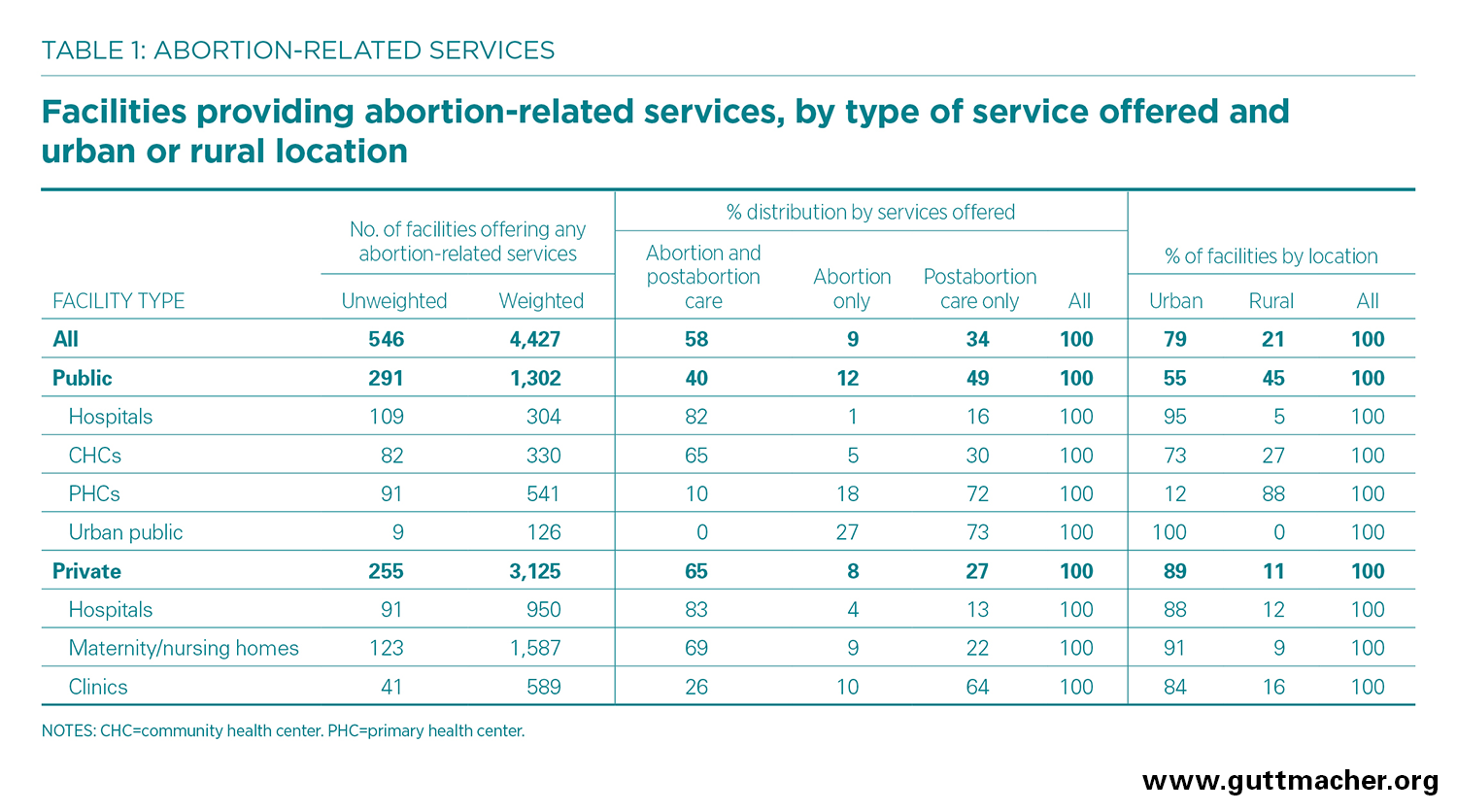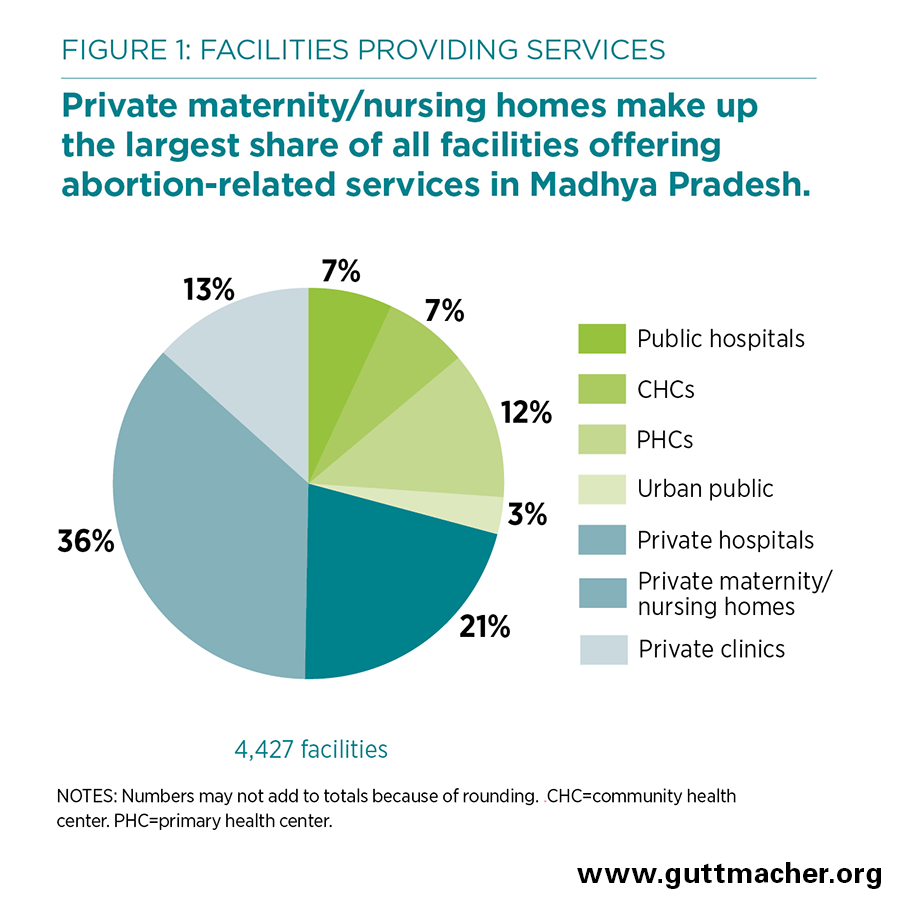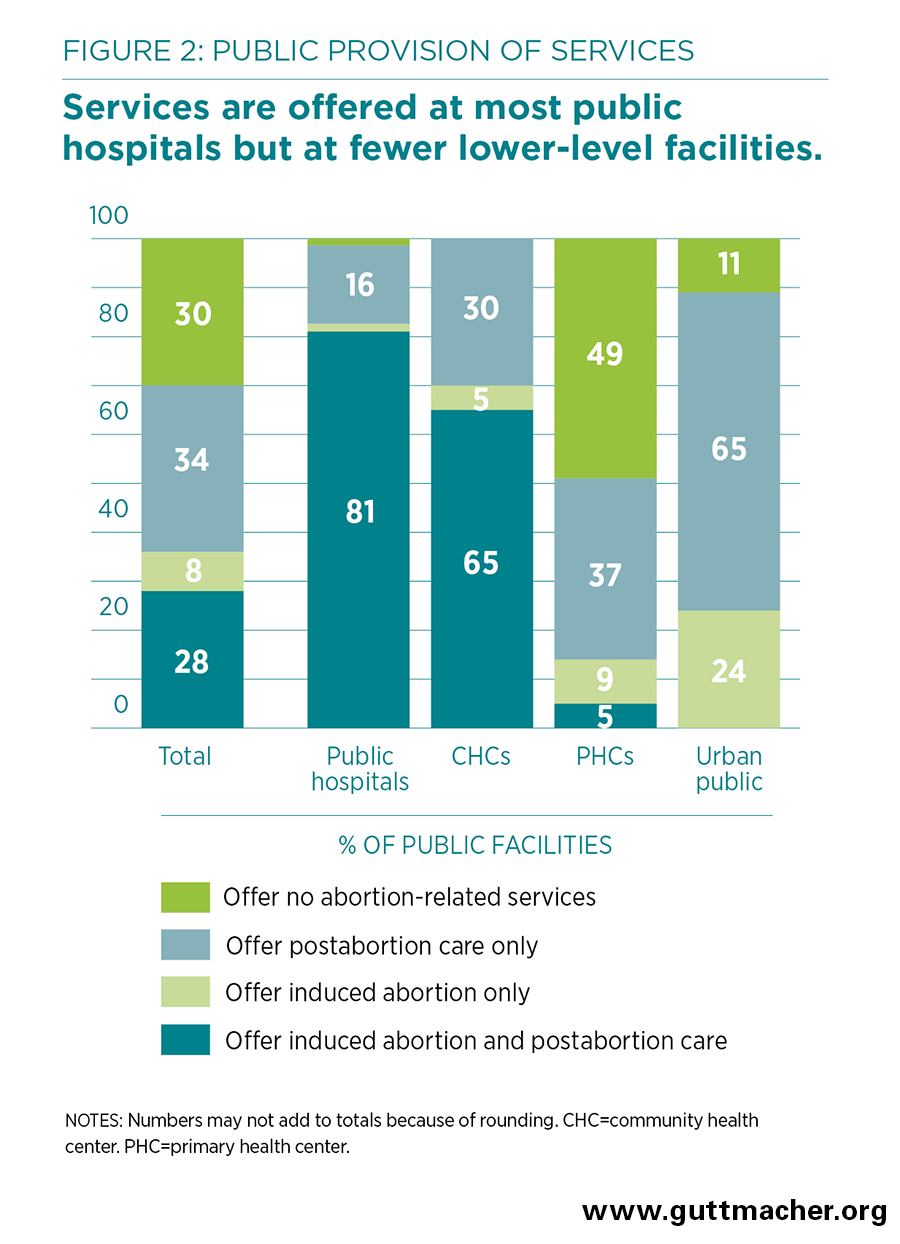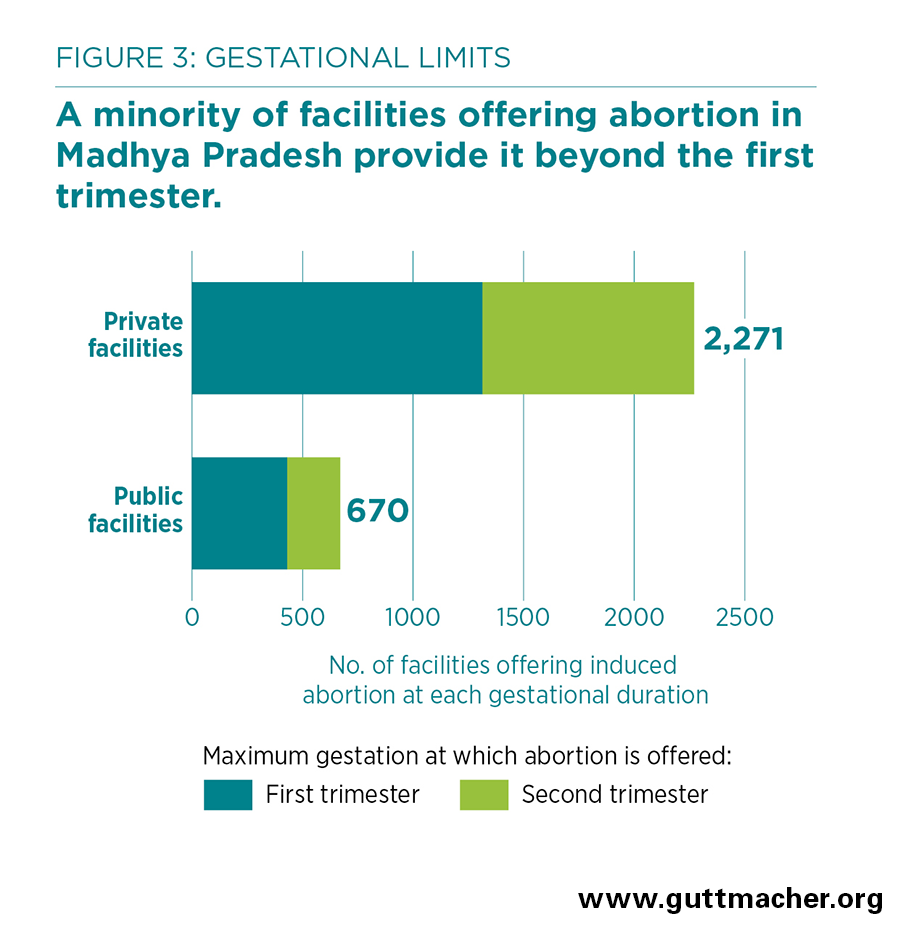In India, induced abortion is legal up to 20 weeks’ gestation, yet there are no state-level representative data on the health care services available to women seeking an abortion or care for complications following an abortion. This fact sheet examines the provision of these vital services in Madhya Pradesh.
Overview of the study
Between March and August of 2015, a team of researchers surveyed a sample of health facilities in six Indian states (Assam, Bihar, Gujarat, Madhya Pradesh, Tamil Nadu and Uttar Pradesh) as part of a study to generate high-quality data on the availability of induced abortion and postabortion care and the incidence of abortion and unintended pregnancy in India.
The study team randomly selected 70% of each state’s districts, and identified and sampled public, private and NGO facilities within these districts. In the public sector, district hospitals, subdivisional hospitals and community health centers (CHCs) were sampled using lists obtained from the Ministry of Health and Family Welfare (MOHFW). A proportion of the primary health centers (PHCs) that are administratively linked to the sampled CHCs were also sampled. In addition, the study team listed and sampled public facilities not listed by MOHFW (urban public facilities), as well as private and NGO facilities (hospitals, medical colleges, maternity and nursing homes, and clinics) that offer induced abortion or postabortion services: In rural areas, facilities located in the catchment areas of a subsample of CHCs were listed, and in urban areas, facilities located within a sample of urban wards were listed. At each sampled facility, trained investigators conducted an in-person interview using a structured questionnaire with a senior professional knowledgeable about the provision of abortion-related services (typically the director or head of the facility or of the department responsible for obstetrics and gynecology). The study and its protocols were approved by the Institutional Review Boards of the three institutions conducting the study.
In Madhya Pradesh, 35 of 50 districts were sampled for inclusion in the study. A total of 385 public facilities (including 291 that reported providing any abortion-related service) completed the survey, as did 249 private facilities and six NGO facilities providing abortion-related services. These facilities represent all 1,848 public facilities operating in Madhya Pradesh (including 1,302 that provide abortion-related services), as well as the 3,125 private and NGO facilities offering abortion or postabortion care in the state. The analysis differentiates facilities according to ownership (public or private) and type (grouped into categories that generally correspond to facility capacity*). Because NGOs make up a very small proportion of our sample, they were combined with private facilities in this analysis. Detailed distributions in tables and figures do not always sum to 100 because of rounding.
- An estimated 4,427 facilities in Madhya Pradesh provide abortion-related services (induced abortion, postabortion care or both; Table 1). Of these, 1,302 are public and 3,125 are private (including NGOs).
- Private maternity and nursing homes make up the largest share of all facilities offering abortion-related services, accounting for 36%, followed by private hospitals, which account for 21% (Figure 1).
- Among facilities offering any such services, 58% offer both abortion and postabortion care, 34% offer only postabortion care and 9% offer only abortion.
- More than four in five public and private hospitals (82–83%) and 69% of private maternity or nursing homes that offer any abortion-related services provide both types of care.
- In contrast, among PHCs that offer any abortion-related services, 72% provide only postabortion care.
- The majority (79%) of facilities offering abortion or postabortion care are located in urban areas. Nearly four in five of these urban facilities (79%) are privately owned.
- In rural areas, however, 62% of facilities that offer abortion-related services are in the public sector.
- Among private facilities offering abortion, 93% report that they are certified under the Medical Termination of Pregnancy Act to provide this service.
Availability of abortion-related services in the public sector
- Seventy percent of all public facilities in Madhya Pradesh offer some type of abortion-related services (Figure 2). Twenty-eight percent offer both induced abortion and postabortion care and 8% offer only abortion, while 34% offer only postabortion care. Thirty percent of public facilities offer neither service.
- Public provision of services varies by facility type: Some 99% of hospitals and 100% of community health centers (CHCs) offer abortion, postabortion care or both, while only 51% of PHCs do so (and most of these offer only postabortion care).
- Thirty-six percent of public facilities in Madhya Pradesh provide induced abortion—83% of hospitals, 70% of CHCs and 14% of PHCs—and almost all of these facilities also offer postabortion care (81% of hospitals, 65% of CHCs and 5% of PHCs).
- Overall, 62% of public facilities provide postabortion care (97% of hospitals, 95% of CHCs and 42% of PHCs), and many offer only postabortion care: 16% of hospitals, 30% of CHCs and 37% of PHCs.
- Viewed another way, the data show that a large majority (64%) of public facilities—17% of hospitals, 30% of CHCs and 86% of PHCs—do not offer abortion.
Reasons for not offering abortion
- Among facilities whose abortion-related services are restricted to postabortion care, the reasons reported for not offering induced abortion vary according to whether facilities are public or private.
- Public facilities offering only postabortion care most commonly cite lack of trained staff (92%) as a reason for not offering induced abortion. They also cite lack of equipment or supplies and lack of space as reasons, but with much less frequency (37% and 28%, respectively).
- Private facilities offering only postabortion care also most commonly report lack of trained staff (66%) as grounds for not offering abortion. Other reasons cited include lack of certification (33%), lack of equipment or supplies (28%), and lack of space (24%). Twenty-two percent cited religious or social reasons, compared with only 3% of public facilities.
- Among all public facilities not offering abortion—those that offer no abortion-related services, as well as those offering only postabortion care—the most prevalent reasons reported for not doing so are similar to those reported by public facilities offering only postabortion care: lack of trained staff (94%) and lack of equipment or supplies (34%).
- In Madhya Pradesh, reasons for not offering abortion vary little by type of public facility.
Types of abortion procedures offered
- Among the public and private facilities that provide induced abortion, 85% offer both medical methods of abortion (MMA)† and surgical methods, 10% offer only MMA and 5% offer only surgical methods.
- Facilities offering abortion report using the following specific methods: MMA using combipacks containing misoprostol and mifepristone (offered by 95%); MMA using only misoprostol (87%); manual vacuum aspiration (MVA) or electric vacuum aspiration (EVA) procedures (81%); and dilatation and evacuation or dilatation and curettage (82%).
- Almost equal proportions of public and private facilities (86% and 85%, respectively) that offer abortion use both MMA and surgical methods.
- Among lower-level facilities that offer abortion, 33% of PHCs and 67% of private clinics limit their provision to MMA.
- In Madhya Pradesh, the vast majority of facilities that offer abortion using MVA or EVA (80–100%) have a trained provider and have functional equipment available all or most of the time when it is needed.
Gestation at which abortion services are offered
- In India, abortion is legal up to 20 weeks’ gestation; for abortions performed between 12 and 20 weeks, authorization by two doctors is required. Pregnancies beyond 20 weeks may be terminated only to save a woman’s life.
- However, most facilities providing abortion services in Madhya Pradesh—59%—offer procedures during the first trimester only (at or before 12 weeks); 18% of facilities restrict provision to the first seven weeks of pregnancy.
- Among the 2,271 private facilities offering abortion, 42% provide services during the second trimester of pregnancy (Figure 3). Of the 670 public facilities offering such care, 36% provide second-trimester procedures.
- The proportion of facilities offering second-trimester procedures is somewhat higher in urban areas (42%) than rural areas (33%).
Consent for abortion procedures
- Providers are required to obtain a woman’s consent before performing an abortion, and the vast majority of facilities (92%) report this is commonly done. This proportion is the same for public and private facilities.
- Consent is not legally required from anyone other than the woman obtaining the procedure, unless she has a mental illness or is a minor. However, many facilities (65%) routinely seek the consent of the woman’s husband or partner. Eleven percent report commonly asking for consent from married women’s in-laws, and 6% report commonly asking the parents of unmarried women.
Turning away abortion seekers
- Overall, an estimated 24% of women seeking induced abortion from facilities offering abortion in Madhya Pradesh were turned away—38% of women seeking abortion from public facilities and 23% seeking abortion from private facilities.
- Fifty-four percent of facilities offering induced abortion report having turned away one or more women seeking an abortion in the last year. Among these facilities, the most common group of reasons for turning away abortion seekers was related to their capacity to provide services—the pregnancy was too far along for the facility, or the facility lacked a trained provider or the requested method (72% of facilities that turned away any abortion seekers reported one or more of these reasons).
- Facilities also report turning away some women who could have been served. Such reasons include that the woman was "too young" (11%), that she had no children (8%) or that she was unmarried (10%). A small proportion of facilities that turn away abortion seekers (6%) do so because the woman’s husband or partner has not consented to the procedure.
Accessibility of postabortion care
- Thirty-six percent of facilities providing postabortion care services (including 55% of public hospitals and 35% of private hospitals) offer care 24 hours a day, seven days a week.
- Overall, availability of around-the-clock postabortion services is similar among facilities providing this care in rural areas (39%) and urban areas (35%). But there are geographical differences in public provision of 24-7 care: In urban areas, it is available at 54% of public hospitals and 49% of CHCs. In rural areas, care is available at 83% of public hospitals and 90% of CHCs. In both urban and rural areas, only 36% of PHCs offer postabortion care 24-7.
- Seventy-six percent of facilities offering postabortion care services provide both outpatient and inpatient care. However, 25% of public facilities and 23% of private facilities offer only outpatient services, indicating that they may not have the capacity to treat severe complications. This includes 19% of public hospitals, 20% of CHCs and 26% of PHCs.
Contraceptive care offered
- Nearly all facilities in Madhya Pradesh that offer abortion-related care report providing information about family planning to the vast majority of women seeking induced abortion or postabortion care services.
- Although many of these facilities cover the correct use of methods (67%), the advantages and disadvantages of different methods (55%), and what methods are available (51%), only a minority provide information on what to do in case of method failure or incorrect use (14%). Slightly more public facilities (18%) than private facilities (12%) report providing information on this topic.
- Nearly all facilities that offer abortion or postabortion care also provide contraceptives. However, facilities report that, on average, 58% of women seeking abortion-related services adopt a contraceptive method. Contraceptive uptake ranges from 51% among clients at private clinics to 62% among clients at public hospitals.
- Twenty-six percent of facilities that offer any abortion-related services report that at least some women are required to adopt contraception as a condition of receiving an abortion. This proportion does not differ much between public and private facilities.





